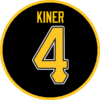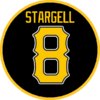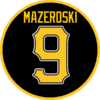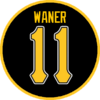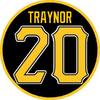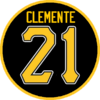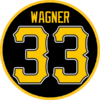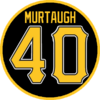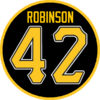Pittsburgh Pirates
| Pittsburgh Pirates | |||||
|---|---|---|---|---|---|
|
| |||||
| Established in 1882 | |||||
| |||||
| Major league affiliations | |||||
| |||||
| Current uniform | |||||
|
| |||||
| Retired numbers | |||||
| Colors | |||||
| |||||
| Name | |||||
| |||||
| Other nicknames | |||||
| |||||
| Ballpark | |||||
| |||||
| Major league titles | |||||
| World Series titles (5) | |||||
| NL Pennants (9) | |||||
| Central Division titles (0) | None | ||||
| East Division titles (9) | |||||
| Wild card berths (3) | |||||
| Front office | |||||
| Owner(s) | Robert Nutting | ||||
| Manager | Clint Hurdle | ||||
| General Manager | Neal Huntington | ||||
| President of Baseball Operations | Neal Huntington | ||||
The Pittsburgh Pirates are an American professional baseball team based in Pittsburgh, Pennsylvania. The Pirates compete in Major League Baseball (MLB) as a member club of the National League (NL) Central division. The Pirates play their home games at PNC Park; the team previously played at Forbes Field and Three Rivers Stadium, the latter of which was named after its location near the confluence of the Allegheny, Monongahela, and Ohio Rivers. Founded on October 15, 1881[1] as Allegheny, the franchise has won five World Series championships. The Pirates are also often referred to as the "Bucs" or the "Buccos" (derived from buccaneer, a synonym for pirate).
The franchise joined the NL in its eighth season in 1887 and was competitive from its early years, winning three NL titles from 1901 to 1903, playing in the inaugural World Series in 1903 and winning their first World Series in 1909 behind Honus Wagner. The Pirates have had many ups and downs during their long history, most famously winning the 1960 World Series against the New York Yankees on a game-winning walk-off home run by Bill Mazeroski, the only time that Game 7 of the World Series has ever ended with a home run, still to this day. They also won the 1971 World Series, led by the talent of Roberto Clemente, and the 1979 World Series under the slogan "We Are Family", led by "Pops" Willie Stargell. Overall, the Pirates have won five World Series and lost two. (The Pirates have won nine NL pennants which implies 9 World Series appearances. However, the first two NL pennants they won, as stated above, were in 1901 and 1902, before the creation of the World Series.)
After a run of regular-season success in the early 1990s (winning three straight East Division titles), the Pirates struggled mightily over the following 20 years, with 20 consecutive losing seasons from 1993 to 2012—the longest such streak in North American professional sports history—before posting a winning record in 2013 of 94–68, qualifying them for the NL Wild Card. They would then advance to the NL Division Series round, where they lost in 5 games to the St. Louis Cardinals. The Pirates would continue their success and make the playoffs in both 2014 and 2015, losing in the Wild Card Game both times.
Franchise history
Professional baseball has been played in the Pittsburgh area since 1876. The teams of the era were "independents", barnstorming throughout the region and not affiliated with any organized league, though they did have salaries and were run as business organizations.[2] On October 15, 1881, the strongest team in the area joined the American Association as a founding member to begin play in 1882.[1] Their various home fields in the 19th century were in a then-separate city called Allegheny City, across the Allegheny River from Pittsburgh. The team was listed as "Allegheny" in the standings, and was sometimes called the "Alleghenys" (not the "Alleghenies") in the same generic way that teams from Boston, New York, and Chicago were sometimes called the "Bostons", the "New Yorks", and the "Chicagos", in the sports writing style of that era. After five mediocre seasons in the A.A., Pittsburgh became the first A.A. team to switch to the older National League in 1887. At this time, the team renamed itself the Pittsburgh Alleghenys,[3] although Allegheny remained a separate city until it was annexed by Pittsburgh in 1907. At that time, owner-manager Horace Phillips sold the team to Dennis McKnight; Phillips stayed on as manager.[4]
Before the 1890 season, nearly all of the Alleghenys' best players bolted to the Players' League's Pittsburgh Burghers. The Players' League collapsed after the season, and the players were allowed to go back to their old clubs. However, the Alleghenys also scooped up highly regarded second baseman Lou Bierbauer, who had previously played with the AA's Philadelphia Athletics. Although the Athletics had failed to include Bierbauer on their reserve list, they loudly protested the Alleghenys' move. In an official complaint, an AA official claimed the Alleghenys' signing of Bierbauer was "piratical".[5] This incident (which is discussed at some length in The Beer and Whisky League, by David Nemec, 1994) quickly accelerated into a schism between the leagues that contributed to the demise of the A.A. Although the Alleghenys were never found guilty of wrongdoing, they made sport of being denounced for being "piratical" by renaming themselves "the Pirates" for the 1891 season.[3] The nickname was first acknowledged on the team's uniforms in 1912. Around the time the team adopted the Pirates nickname, the United States Board on Geographic Names forced the city of Pittsburgh to undergo a controversial name change by having them drop the "h" at the end of the name, making the team's official name the "Pittsburg Pirates" from the adoption of the Pirates nickname until Pittsburgh was able to get the "h" restored to its name in 1911.
The Pirates were a strong team in the early 1900s, winning National League pennants from 1901–1903 and taking their first World Series title in 1909. They again won the NL in 1925 and 1927 and the World Series in 1925. After a slow period, they returned to dominance and won the 1960 World Series, 1971 World Series and 1979 World Series. They won Eastern Division titles from 1990–1992 but did not return to the post-season after that until 2013.
On Opening Day 2015 the Pirates' loss to the Cincinnati Reds represented its 10,000th franchise loss since moving to the NL. This made the Pirates the fourth MLB team to achieve this distinction, following the Philadelphia Phillies, Atlanta Braves, and Chicago Cubs.[6] Their victory over the Colorado Rockies later in 2015 on September 24 made them the 7th team in MLB history to reach 10,000 wins.
Rivalries
Historical
Philadelphia Phillies
The rivalry between the Philadelphia Phillies and the Pirates was considered by some to be one of the best rivalries in the National League.[7][8][9] The rivalry started when the Pittsburgh Pirates entered the NL in 1887, four years after the Phillies.[10]
The Phillies and the Pirates had remained together after the National League split into two divisions in 1969. During the period of two-division play (1969 to 1993), the two National League East division rivals won the two highest numbers of division championships, reigning almost exclusively as NL East champions in the 1970s and again in the early 1990s.[9][11][12] the Pirates nine, the Phillies six; together, the two teams' 15 championships accounted for more than half of the 25 NL East championships during that span.[11]
After the Pirates moved to the National League Central in 1994, the teams face each other only in two series each year and the rivalry has diminished.[8][9] However, many fans, especially older ones, retain their dislike for the other team, with regional differences between Eastern and Western Pennsylvania still fueling the rivalry.[13]
Within the Central Division
The Pirates have long-standing, albeit sometimes dormant, rivalries with their fellow NL Central Division teams, including the Cincinnati Reds, St. Louis Cardinals, Milwaukee Brewers (with the The Sausage incident and the 'You can steal first' game) and the Chicago Cubs (with the Homer in the Gloamin' and most recently, the 2015 NL Wild Card game). The intensity of the rivalries often depend upon the competitiveness of the teams involved during that season.
Current roster
Players
Baseball Hall of Fame
| Pittsburgh Pirates Hall of Famers |
|---|
| Affiliation according to the National Baseball Hall of Fame and Museum |
|
Ford C. Frick Award recipients
| Pittsburgh Pirates Ford C. Frick Award recipients | |||||||||
|---|---|---|---|---|---|---|---|---|---|
| Affiliation according to the National Baseball Hall of Fame and Museum | |||||||||
|
Team captains
- Dick Groat -1962
- Bill Mazeroski 1963–1972
- Willie Stargell 1973–1982
Retired numbers
|
Franchise records
Won-loss records
- 100 Wins in a Season
- 1902 (103–36), Fred Clarke
- 1909 (110–42), Fred Clarke
- 100 Losses in a Season
- 1890 (23–113), Guy Hecker
- 1917 (51–103), Jim Callahan, Honus Wagner, and Hugo Bezdek
- 1952 (41–113), Billy Meyer
- 1953 (50–104), Fred Haney
- 1954 (53–101), Fred Haney
- 1985 (57–104), Chuck Tanner
- 2001 (62–100), Lloyd McClendon
- 2010 (57–105), John Russell
First-in-MLB accomplishments
- First ever Major League Baseball game broadcast on the radio, a game between the Pirates and the host Philadelphia Phillies aired August 5, 1921, on KDKA (AM) Pittsburgh. The Pirates won the game 8–5.
- In 1925, the Pirates became the first MLB team to recover from a 3-games-to-1 deficit in winning a best-of-seven World Series; they then became the first MLB team to repeat that feat in 1979.[14][15]
- During the 1953 season, the Pirates became the first team to permanently adopt batting helmets on both offense and defense. These helmets resembled a primitive fiberglass "miner's cap". This was the mandate of general manager Branch Rickey, who also owned stock in the company producing the helmets. Under Rickey's orders, all Pirate players had to wear the helmets both at bat and in the field. The helmets became a permanent feature for all Pirate hitters, but within a few weeks the team began to abandon their use of helmets in the field, partly because of their awkward and heavy feel. Once the Pirates discarded the helmets on defense, the trend disappeared from the game.[16] In 2014, Major League Baseball allowed pitchers to choose to wear a padded hat that aims to combine the added safety of a helmet with the comfort of a baseball cap.[17] The cap would prove widely unpopular, with only Alex Torres of the New York Mets choosing to wear it.[18]
- First franchise to win a World Series on a home run (1960 World Series) in the 7th game. The only other team to meet this feat is the Toronto Blue Jays in 1993, though they accomplished it in game 6.
- In 1970 the Pirates became the first major league club to create their uniforms using a cotton-nylon blend featuring pull-over shirts and beltless pants.[19]
- The first all-minority lineup in MLB history took the field on September 1, 1971.[20] The lineup was Rennie Stennett, Gene Clines, Roberto Clemente, Willie Stargell, Manny Sanguillén, Dave Cash, Al Oliver, Jackie Hernandez, and Dock Ellis.[21]
- The first World Series night game was played in Three Rivers Stadium on October 13, 1971 — eleven years to the day since Mazeroski's walk-off homer brought the Pirates their last World Series title in 1960. In this case, however, it was Game 4 between the Pirates and the Baltimore Orioles, rather than a decisive Game 7. Apparently, good things happen for the Pirates on this date, as they knotted the '71 Series at two games apiece on their way to their fourth title.
- The first MLB scout to win the "Scout of the Year Award", Howie Haak, in 1984, three additional scouts from the organization have subsequently won the award.
- The first combined extra inning no-hitter in MLB history took place at Three Rivers Stadium on July 12, 1997. Francisco Córdova (9 innings) and Ricardo Rincón (1 inning) combined to no-hit the Houston Astros, 3–0 in 10 innings. Pinch-hitter Mark Smith's three-run walk-off home run in the bottom of the 10th inning sealed the victory and the no-hitter for the Pirates. It remains the only such no-hitter to date.[22]
- In November 2008, the Pirates became the first MLB team to sign Indian players when they acquired the non-draft free agents of Rinku Singh and Dinesh Patel.[23][24] This was also seen by Pirates general manager Neal Huntington, as "not only add[ing] two prospects to our system but also hope to open a pathway to an untapped market."[25]
- The Pirates are the first team in professional sports to have 20 consecutive losing seasons. This streak lasted from 1993 to 2012. This is the longest such streak in North American professional sports history.
- The Pirates are the first MLB team (as well as only second in major professional sports) to be owned by an openly gay owner, although Kevin McClatchy had already divested his shares in the Pirates when he openly announced his homosexuality in September 2012.[26][27]
- On April 6, 2015, the Pirates' loss to the Cincinnati Reds earned the team its 10,000 franchise loss and making the Pirates the first MLB team to reach their 10,000th loss on an Opening Day.[6]
- On May 9, 2015, the Pirates became the first MLB team to turn a 4–5–4 triple play. The triple play occurred during a 7–5 win over the St. Louis Cardinals. The play occurred when the Cardinals' Yadier Molina lined out to Pittsburgh second baseman Neil Walker. Walker then threw to third baseman Jung Ho Kang to double off the Cardinals' Jhonny Peralta for the second out. Kang then threw the ball back to Walker, who was standing on second base. for the final out after St. Louis’ Jason Heyward froze between second and third.[28]
Minor league affiliations
| Level | Team | League | Location | Years |
|---|---|---|---|---|
| AAA | Indianapolis Indians | International League | Indianapolis, Indiana | 2005– |
| AA | Altoona Curve | Eastern League | Altoona, Pennsylvania | 1999– |
| Advanced A | Bradenton Marauders | Florida State League | Bradenton, Florida | 2010– |
| A | West Virginia Power | South Atlantic League | Charleston, West Virginia | 2009– |
| Short Season A | West Virginia Black Bears | New York–Penn League | Morgantown, West Virginia | 2015– |
| Rookie | Bristol Pirates | Appalachian League | Bristol, Virginia | 2014– |
| GCL Pirates | Gulf Coast League | Bradenton, Florida | 1978– | |
| DSL Pirates 1 | Dominican Summer League | Dominican Republic | 1990– | |
Civil rights advocacy
Throughout the 1940s Pirates owner William Benswanger was a leading advocate of integration of the Major Leagues, once planning a tryout for African American players to sign up for the club.[29]
The Pirates organization was the first in baseball to have both an African-American coach and manager, when Gene Baker broke the color line in 1961 and 1962 respectively. On September 21, 1963 the Pirates were the first MLB team to have an African-American manager in Gene Baker, as he filled in for Danny Murtaugh.[30]
On September 1, 1971, manager Murtaugh assembled a starting lineup that was completely composed of minorities for the first time in MLB history.[31]
Fanbase
Despite having some notable fans including former part-owner Bing Crosby, Michael Keaton and Regis Philbin,[32] the Pirates are considered by most to be a distant third in Pittsburgh behind the Pittsburgh Steelers and Pittsburgh Penguins in popularity among Pittsburgh's three major professional sports teams. Many surveys have backed up this finding as well.[33] However, due to their long history in Pittsburgh dating back to the 1882 season, the team has retained a strong loyal following in the Pittsburgh region.
While the team's recent struggles compared to Pittsburgh's other two teams can be partly to blame (since the Pirates last World Series championship in 1979, the Steelers have won the Super Bowl 3 times (XIV, XL, and XLIII) and the Penguins the Stanley Cup four times in 1991, 1992, 2009, and 2016, including both in 2009), distractions off the field have also caused the team's popularity to slip in the city. While the team was ranked first in Pittsburgh as recent as the late 1970s,[34] the Pittsburgh drug trials in 1985 and two relocation threats since are believed to have also seen the team's popularity dipped.[35] The team's standing among fans has, however, improved along with the team on the field and the opening of PNC Park in 2001.[36]
Community activities
Each year, the Pirates recognize six "Community Champions" during a special pregame ceremony.[37]
Piratefest is a yearly event that is held by the Pittsburgh Pirates in January. The event is, in essence, a baseball carnival for the whole family. It features autograph sessions from current and former Pirates players and coaches, live events and games, carnival booths, baseball clinics, "Ask Pirates Management", and appearances by the Pirate Parrot. Piratefest is held at the David L. Lawrence Convention Center in downtown Pittsburgh.[38]
Radio and television
In 2007, the Pirates chose to end the longest relationship between a team and a radio station in American professional sports. KDKA first broadcast the Pirates on August 5, 1921; with Westinghouse foreman Harold Arlin behind the mic. Broadcasts ended in 1924, but returned in 1936. Except for a few years on WWSW in the late 1940s and early 1950s, the Pirates were on KDKA for 61 years. KDKA's 50,000-watt clear channel enabled Pirates fans across the eastern half of North America at night to hear the games.
That changed for the 2007 season, when the Pirates moved to FM talk radio station WPGB. The Pirates cited the desire to reach more people in the 25–54 age bracket coveted by advertisers. The acquisition of the rights means that Clear Channel Communications holds the rights to every major sports team in Pittsburgh. The Pirates have long had a radio network that has extended across four states. Stations for the 2007 season include Pennsylvania, West Virginia, Ohio, and Maryland radio broadcasters.[39]
On October 1, 2011, Clear Channel announced that they will not renew their deal with the Pirates. It was speculated that the club's radio broadcasting rights would likely be transferred back to CBS Radio via FM sports radio station KDKA-FM,[40] which became official on October 12.[41] On March 2, 2016 it was announced a new deal was reached for the Pirates to remain on KDKA-FM.[42]
Games are televised on Root Sports Pittsburgh, the Pirates' cable television outlet since 1986, when it was known as KBL. There has been no over-the-air coverage of the Pirates since 2002, when some games were on WCWB. KDKA-TV aired Pirates games for 38 years (1957–1994). Games aired on WPXI (1995–1996) and on WPGH-TV and WCWB (1997–2002).
Announcers Greg Brown, Bob Walk, John Wehner, and Steve Blass shuttle between the radio and TV booths. After the departure of play-by-play announcer Tim Neverett, who accept a play-by-play radio position with the Boston Redsox[43] following the 2015 season, former Milwaukee Brewers announcer Joe Block will begin Play-by-Play Duties beginning with the 2016 season. Former Pirates closer Kent Tekulve, a member of the team's 1979 World Series Championship team, serves as a post-game analyst for the team on Root Sports Pittsburgh.
On October 1, 2008, longtime play-by-play announcer Lanny Frattare retired after 33 seasons, having called Pirates' games since the 1976 season. He is the longest-tenured announcer in Pirates' history, surpassing the man he replaced, the late Bob Prince (28 seasons, 1948–1975).
Figures with broadcasting resumés
Logos and uniforms
 1888: "Alleghenys" Logo
1888: "Alleghenys" Logo 1900–1906
1900–1906 1907
1907 1908–1909
1908–1909 1915–1919
1915–1919 1921, 1932
1921, 1932 1922
1922 1923–1931
1923–1931 1933–1935
1933–1935 1936–1947
1936–1947 1948–1959
1948–1959 1960–1967
1960–1967 1968–1986
1968–1986 1987–1996
1987–1996 1997–2013,[44] 2014–present: Secondary Logo
1997–2013,[44] 2014–present: Secondary Logo 1997–2009: Alternate Logo
1997–2009: Alternate Logo 2010–present: Alternate Logo
2010–present: Alternate Logo 2014–present
2014–present
The Pirates have had many uniforms and logo changes over the years, with the only consistency being the "P" on the team's cap. It was adopted in 1948. Aside from style changes in the cap itself, the "P" logo has remained since.
The Pirates have long been innovators in baseball uniforms. In 1948, the team broke away from the patriotic "Red, White, & Blue" color scheme when they adopted the current black & gold color scheme, to match that of the colors of the Flag of Pittsburgh and, to a lesser extent at the time, the colors of the then-relatively unknown Pittsburgh Steelers of the NFL. While they were not the first baseball team to do this, they were one of the first to do this permanently. Along with the San Francisco Giants, the Pirates are one of two pre-expansion National League teams that completely changed their colors, although red returned as an "accent color" in 1997 and remained until 2009.
In the late 1950s, the team adopted sleeveless jerseys. While not an innovation by the team (that honor goes to the Cincinnati Reds), the Pirates did help to popularize the look. The team brought back the vested jerseys in 2001, a style they retained until 2009, although the away jerseys said "Pittsburgh" in script instead of "Pirates." In 2009, they introduced a new home, away and alternate black jersey all with sleeves. However, they kept the pinstriped sleeveless vest for Sunday home games.
To coincide with the move into Three Rivers Stadium in 1970, the team introduced pullover spandex uniforms, the first such team in baseball, and a look that would quickly be adopted by most other teams by the end of the decade. The Pirates ditched the pullover style in favor of the traditional button-down style in 1991, one of the last teams to switch.
The Pirates were also innovators in third jerseys. Even though it would be the Oakland A's that would beat them to having such jerseys, the Pirates, by 1977 had different uniform styles that included two different caps, two different undershirts, three different jerseys and three different pairs of trousers. They would actually rotate (and sometimes mix, with painful results) these styles daily until returning to the basic white and gray uniform ensemble in 1985.
In 1976, the National League celebrated its 100th anniversary. To coincide with it, certain NL teams wore old-style pillbox hats complete with horizontal pinstripes. After the season, the Pirates were the only team to adopt the hats permanently, (alternating between a black hat and a gold hat for several seasons until keeping the black hat in 1985) and kept the hat through the 1986 season, which would be Barry Bonds rookie season with the team. The hats, which recall the team's last World Series championship season (1979), remain popular items in the throwback market.
The 2013 season marked the last of one of the team's former logos, introduced in 1997 just after former owner Kevin McClatchy took over the team. The Pirates chose to use the "P" on their caps as the primary logo; however, the former logo will continue to be used as a secondary logo.[45]
On December 13, 2014, the Pirates unveiled a new camo alternate jersey, which honors the soldiers in the Armed Forces. It was worn on every Thursday home game during the 2015 season.
On February 18, 2016, the Pirates unveiled a new throwback alternate uniform in the style of the 1979 team. This uniform features yellow jerseys and old-style pillbox hats. It will be worn on every Sunday home game during the 2016 season.[46]
See also
References
- General
- Markusen, Bruce. The Team That Changed Baseball: Roberto Clemente and the 1971 Pittsburgh Pirates.[47] Yardley: Westholme Publishing. 2005. ISBN 1-59416-030-9
- McCollister, John (1998). The Bucs!: The Story of the Pittsburgh Pirates. Lenexa: Addax Publishing Group. ISBN 1-886110-40-9.
- Nemec, David (2004). The Beer and Whisky League : The Illustrated History of the American Association—Baseball's Renegade Major League. Guilford: The Lyons Press. ISBN 1-59228-188-5.
- In-line citations
- 1 2 https://books.google.com/books/about/Denny_McKnight.html?id=6pAJywAACAAJ
- ↑ Pittsburgh Pirates | BaseballLibrary.com
- 1 2 "Pirates official team history, part 1". Pittsburgh.pirates.mlb.com. Retrieved December 5, 2010.
- ↑ Purdy, Dennis (2006). The Team-by-Team Encyclopedia of Major League Baseball. New York City: Workman. ISBN 0-7611-3943-5.
- ↑ Why is our baseball team called the Pirates? Pittsburgh City Paper, August 14, 2003.
- 1 2 Wilmoth, Charlie (April 6, 2015). "Johnny Cueto, Todd Frazier help Reds beat Pirates 5–2 on Opening Day". Bucs Dugout. Retrieved June 10, 2015.
- ↑ Woolsey, Matt (April 28, 2009). "In Depth: Baseball's Most Intense Rivalries". Forbes.
- 1 2 Collier, Gene (July 4, 2005). "Pirates—Phillies: A Rivalry Lost and Missed". Pittsburgh Post-Gazette. p. D1.
- 1 2 3 Von Benko, George (July 7, 2005). "Notes: Phils–Pirates rivalry fading". Philadelphia Phillies. MLB. Retrieved January 3, 2011.
- ↑ Stark, Jayson (September 10, 1993). "Baseball Owners Vote to Break Each League Into Three Divisions". Philadelphia Inquirer. p. A1.
- 1 2 Collier, Gene (September 27, 1993). "Pirates, Phillies Have Owned the Outgoing NL East Division". Pittsburgh Post-Gazette. p. D1.
- ↑ "Pirates perform rare three-peat feat 4–2". USA Today. September 28, 1992. p. 5C.
- ↑ "It's Philly vs. the Burgh". Pittsburgh Post-Gazette. May 11, 2008. p. B1.
- ↑ "World Series 1–3 Comebacks – MLB". ESPN. October 27, 2008. Retrieved December 5, 2010.
- ↑ MLB.com (January 2, 2010). "LCS, World Series 3–1 comebacks | MLB.com: News". Mlb.mlb.com. Retrieved December 5, 2010.
- ↑ "Oakland A's Fan Coalition – Athletics baseball enthusiasts dedicated to watching a winner". Oaklandfans.com. July 12, 1980. Retrieved December 5, 2010.
- ↑ "MLB approves protective cap for pitchers in time for 2014 season". Retrieved 2014-04-26.
- ↑ MLB.com – Torres the first to try out protective cap in game
- ↑ "Dressed to the Nines: A History of the Baseball Uniform". National Baseball Hall of Fame and Museum. Retrieved November 26, 2014.
- ↑ John Perrotto (August 14, 2006). "Baseball Plog". Beaver County Times.
- ↑ "Honoring First All-Minority Lineup". New York Times. September 17, 2006. p. Sports p. 2.
- ↑ Sporting News description and assertion of first combined extra-innings no hitter; Box score via Baseball Reference
- ↑ Jenifer Langosch / MLB.com (January 2, 2010). "Indian hurlers' inking opens new market | pirates.com: News". Pittsburgh.pirates.mlb.com. Retrieved December 5, 2010.
- ↑ "Pirates find 2 pitchers from Indian reality show – Baseball- NBC Sports". Nbcsports.msnbc.com. November 25, 2008. Retrieved December 5, 2010.
- ↑ Jenifer Langosch / MLB.com (January 2, 2010). "Bucs sign pair of Indian hurlers | pirates.com: News". Pittsburgh.pirates.mlb.com. Retrieved December 5, 2010.
- ↑ Bruni, Frank (2012-02-22). "Coming Out in the World of Sports". New York Times. Retrieved 2012-09-22.
- ↑ Ex-Pittsburgh Pirates owner Kevin McClatchy comes out as gay – ESPN. Espn.go.com (2012-09-26). Retrieved on 2013-07-23.
- ↑ Abrotsky, Justin L.; Stone, Avery (May 9, 2015). "Pittsburgh Pirates pull off first 4–5–4 triple play in MLB history against Cardinals". USA Today. Retrieved May 11, 2015.
- ↑ Negro League Baseball: The Rise and Ruin of a Black Institution – Neil Lanctot – Google Books. Books.google.com. Retrieved on 2013-07-23.
- ↑ Let us not forget about Gene Baker. Thesouthern.com (2013-02-19). Retrieved on 2013-07-23.
- ↑ Vascellaro, Charlie (September 1, 2011). "Bucs broke ground with first all-minority lineup". Major League Baseball Advanced Media. Retrieved May 18, 2016.
- ↑ Regis Philbin Pulling For Pirates To End Pitiful Streak – Pittsburgh News Story – WTAE Pittsburgh
- ↑ Anderson, Shelly (November 7, 2007). "Penguins Notebook: In this case, No. 20 ranking is huge". Pittsburgh Post-Gazette. Retrieved June 7, 2008.
- ↑ America's Game: The Super Bowl Champions. The 1979 Pittsburgh Steelers
- ↑ Cook, Ron (September 29, 2000). "The Eighties: A terrible time of trial and error". Pittsburgh Post-Gazette.
- ↑ Pittsburgh Pirates Fans Hopeful At Home Opener At PNC Park « CBS Pittsburgh
- ↑ "Annual African American Heritage Weekend Friday, August 20 and Saturday, August 21 to be Hosted by Pitsburg Pirates". Ask Blackie: African American Entertainment, Music, News and Anything Afro-American. Ask Blackie. Retrieved November 3, 2011.
[People] all nominated by their fellow citizens for having positively contributed to the betterment of the diverse community in our region.
- ↑ Piratefest webpage
- ↑ "Pirates Radio Network | pirates.com: Schedule". Pittsburgh.pirates.mlb.com. January 2, 2010. Retrieved December 5, 2010.
- ↑ "Smizik on Sports – Pittsburgh Post-Gazette". Communityvoices.sites.post-gazette.com. Retrieved 2013-10-02.
- ↑ "Pirates, KDKA-FM agree to broadcasting deal". Pittsburgh.pirates.mlb.com. October 12, 2011. Retrieved October 12, 2011.
- ↑ "Pirates, KDKA-FM agree to new contract". Post-Gazette.com. March 2, 2016. Retrieved March 2, 2016.
- ↑ "Pirates broadcaster leaves for Boston". Post-Gazette.com. December 28, 2015. Retrieved March 3, 2016.
- ↑ Cohen, Bob (February 11, 2013). "Pirates will commission new logo for 2014 season". Pittsburgh Tribune-Review.
- ↑ "Pirates ditch Jolly Roger logo". ESPN. Associated Press. January 8, 2014. Retrieved December 24, 2015.
- ↑ "Pittsburgh Pirates new 1979 uniforms jersey 2016". MLB.com. February 18, 2016. Retrieved March 3, 2016.
- ↑ "The Team That Changed Baseball: Roberto Clemente and the 1971 Pittsburgh Pirates". Westholme Publishing. April 3, 2006. Retrieved December 5, 2010.
External links
| Wikimedia Commons has media related to Pittsburgh Pirates. |


